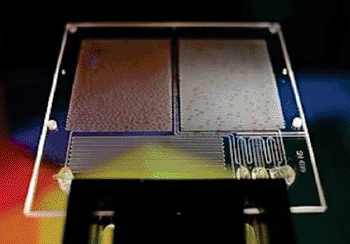Different Bacteria Cultures Maintained in Microfluidic System
By LabMedica International staff writers
Posted on 13 Aug 2013
A fabricated microfluidic device allows hundreds of different bacteria cultures to be maintained simultaneously. Posted on 13 Aug 2013
The system allows for the merging, transporting and splitting of microdroplets where strictly controlled chemical reactions and the cultivation of bacterial colonies can be performed.

Image: Microfluidic system for multiple bacterial cultures (Photo courtesy of Polish Institute of Physical Chemistry).
A group of scientists at the Institute of Physical Chemistry (Warsaw, Poland) engineered the microfluidic systems from polymer plates that correspond to the size of a credit card. Inside the system, a carrier fluid, mostly oil, carries microdroplets containing chemicals, flows laminarly through tiny channels of diameters in the range of tenths or hundredths of a millimeter. In this single microfluidic system thousands of different chemical reactions can be carried out during a day.
The microsystem is composed of two branches of microchannels forming densely arranged zigzags. A few hundred droplets can circulate in the microchannels, at a distance of about one centimeter from each other. The microdroplets move in a pendular movement from one branch to the other. Each droplet circulating within the microfluidic system has its own unique identifier, assigned by the optoelectronic system. It allows the scientist to monitor at any time what operations have been carried out on each microdroplet. A single droplet can include over 100,000 bacteria that are unable to move between the droplets, as the bacteria cannot cross the surface membrane of a microdroplet, and the carrier liquid used to transport microdroplets is not an environment favorable for the life of bacteria.
Piotr Garstecki, PhD, DSc, the lead author, said, “We can transform each microdroplet into a real bioreactor. Therefore, in a single small plate we can have up to several hundreds of bioreactors, with different, controlled concentration of an antibiotic, a different antibiotic or even different bacterial species in each bioreactor.” The paper was published on July 15, 2013, in the journal Angewandte Chemie International Edition.
Related Links:
Polish Institute of Physical Chemistry













